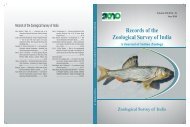Vol. 111 - Part I - Zoological Survey of India
Vol. 111 - Part I - Zoological Survey of India
Vol. 111 - Part I - Zoological Survey of India
You also want an ePaper? Increase the reach of your titles
YUMPU automatically turns print PDFs into web optimized ePapers that Google loves.
MITRA : Remarks on Lamarckian concept <strong>of</strong> animal evolution and philosophy <strong>of</strong> biology 7<br />
carried for thousands <strong>of</strong> years without producing any<br />
heritable effect. The practice causes pains to the<br />
subjects which they do not need for their survival. (2)<br />
The thickened skin on the sole <strong>of</strong> human foot and the<br />
sternal and allar callosities <strong>of</strong> the Ostrich, seem to be<br />
directly related to pressure arising from the habitual<br />
position <strong>of</strong> these animals. The callosities are also visible<br />
in embryos, in which the callosities are not needed at<br />
all, but they are hereditarily fixed. In these cases subjects<br />
need was for survival on the hard surface.<br />
Lamarckbelieved it, but in restricted sense. According<br />
to Lull (1922) Lamarck believed it but never tried to<br />
prove. Mayr (1976) observed that Lamarck said about<br />
the mechanism by which transmission takes place.<br />
Hardy (1974) commented, that Lamarck’s contention<br />
that changes in the environment can bring about<br />
changes in the habit was overlooked. And “he should<br />
perhaps be given more credit for having being the first<br />
to insist that changes in habit would form an important<br />
element in the process”. Simpson (1961) refuted the<br />
contention that Lamarck believed the importance <strong>of</strong><br />
inheritance <strong>of</strong> acquired character in a strong word. He<br />
wrote, “Lamarck would be astonished to know that<br />
“Lamarckism” has come to mean the inheritance <strong>of</strong><br />
acquired characters. In the first place, he did not believe<br />
that all acquired characters are heritable, and in the<br />
second place in saying that some are, he was only<br />
repeating what everyone “knew” and had “known”<br />
since antiquity.”<br />
Lamarck in the Second Law said, “All acquisitions<br />
or losses wrought by nature on individuals......are<br />
preserved by reproduction to the new individuals which<br />
arise, provided that the acquired modifications are<br />
common to both sexes, or at least to the individuals<br />
which produce the young” (P. 113). Again in the page<br />
124 he said, “Now every change that is wrought in an<br />
organ through a habit <strong>of</strong> frequently using it, is<br />
subsequently preserved by reproduction, if it is<br />
common to individuals who unite together in<br />
fertilization for the propagation <strong>of</strong> their species. Such a<br />
change is thus handed on to all succeeding individuals<br />
in the same environment, without their having to acquire<br />
it in the same way that it was actually created.”<br />
From the above it is clear that Lamarck did not try<br />
to prove the importance <strong>of</strong> inheritance <strong>of</strong> acquired<br />
characters in evolution. Repeatedly he tried to point<br />
that changes in the enviornment can bring about<br />
changes in the habits <strong>of</strong> animals and that is those<br />
changes <strong>of</strong> habit which can be so important in bringing<br />
about evolutionary changes (Hardy, 1974).<br />
4. Isolation and geographical race formation :<br />
Dobzhansky (1951) pointed out both Lamarck and<br />
Darwin believed that the interbreeding <strong>of</strong> genetically<br />
distinct populations result in swamping <strong>of</strong> the<br />
differences. In page 112 Lamarck wrote, “When the<br />
observing naturalist travels over large portions <strong>of</strong> the<br />
earth’s surface and sees conspicuous changes<br />
occurring in the environment, he invariably finds that<br />
the characters <strong>of</strong> species undergo a corresponding<br />
change.” In the matter <strong>of</strong> domenstication <strong>of</strong> dog<br />
Lamarck wrote in pages 110-<strong>111</strong>, “No doubt a single,<br />
original race, closely resembling the wolf, if indeed it<br />
was not actually the wolf, was at some period reduced<br />
by man to domestication. That race, <strong>of</strong> which all the<br />
individuals were then alike, was gradually scattered with<br />
man in to different countries and climates; and after<br />
they had been subjected for sometime to the influences<br />
<strong>of</strong> their environment and <strong>of</strong> the various habits which<br />
had been forced upon them in each country, they<br />
underwent remarkable alterations and formed various<br />
special races.” In these statements Lamarck hinted on<br />
isolation as a factor in evolution.<br />
5. Slow and gradualness <strong>of</strong> evolution :<br />
Lamarck’s belief on the slow and gradualness <strong>of</strong><br />
evolutionary changes is available in the following<br />
statements : In page 11 he wrote, “With regard to living<br />
bodies, it is no longer possible to doubt that nature<br />
has done everything little by little and successively’;<br />
in page 70 he wrote about the aquatic animals,<br />
“......nature led them little by little to the habit <strong>of</strong> living<br />
in the air, first by the water’s edge and afterwards on<br />
all the dry parts <strong>of</strong> the globe etc.” On slow and<br />
gradualness and imperceptibility <strong>of</strong> evolutionary<br />
changes in page 30 he said, “These changes only take<br />
place with an extreme slowness, which make them<br />
always imperceptible.” Again in page 50 he wrote, “An<br />
enormous time and wide variation in successive<br />
conditions must doubtfless have been required to<br />
enable nature to bring the organization <strong>of</strong> the animals<br />
to that degree <strong>of</strong> complexity and development in which<br />
we see it at its perfection.” In page 114 Lamarck<br />
remarked for nature, “time has no limits and can be<br />
drawn upon to any extent.”<br />
Although Lamarck has not said anything on Natural<br />
Selection but he mentioned the nature’s ability to<br />
produce perfect forms. Lamarck said that nature<br />
produces the perfect forms; Darwin said nature selects<br />
the (?) perfect forms able to survive in the environment.
















